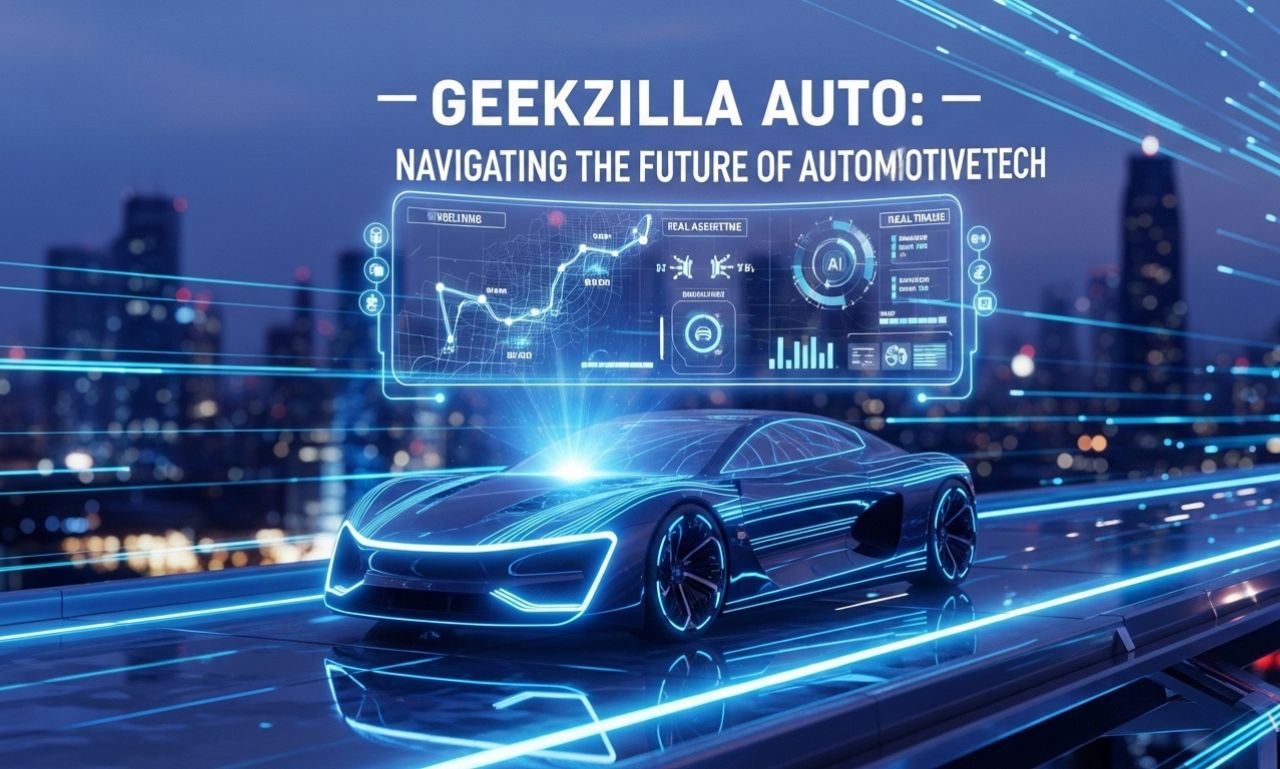Geekzilla Auto stands at the intersection of automotive passion and technology-driven innovation. In an era when vehicles transcend mere transportation and become smart devices on wheels, the concept of Geekzilla Auto embodies a future-forward vision: where driving is amplified by software, connectivity, green power and community engagement. This article explores what Geekzilla Auto means today, how it’s evolving, its benefits, challenges, and why it matters to anyone who cares about cars, tech or mobility.
What is Geekzilla Auto
The term “Geekzilla Auto” originally appears in online platforms as a branded segment describing automotive content: reviews, tech features, commentary on electric vehicles and driving trends. One prominent site describes it as “a place where you will get an unlimited feed of new and relevant information related to automobiles.” Thus, at its foundation Geek zilla Auto is less a specific car manufacturer and more a concept or platform bridging the enthusiastic “geek” mindset with autos.
However, alongside this informational usage, some pockets of content treat Geek zilla Auto as though it were a full-scale automotive brand: electric vehicles, autonomous driving, futuristic designs. These dual identities—content platform and imagined brand—give Geekzilla Auto an intriguing ambiguous status. Whether you’re reading about it as a blog series or speculating about its products, the concept invites exploration of how automotive culture is shifting.
Why Geekzilla Auto Matters in Today’s Landscape
In recent years, the automotive industry has changed dramatically. Traditional engine tech, sedans and simple functions are giving way to electric drivetrains, advanced driver assistance systems (ADAS), vehicle connectivity, software updates and even mobility as a service. Geekzilla Auto matters because it captures this transformation from the enthusiast side. It offers a lens into the tech-driven future of mobility, in which the car is not just hardware but software, community and experience.
For example, when someone speaks of “Geekzilla Auto innovations,” they might refer to integrating artificial intelligence for self-driving features, or pairing a car’s functions with a smartphone app to control charging, climate or even door locks. They might talk about how an electric car from the Geekzilla ethos would be designed with minimalist styling, connectivity, high-efficiency battery technology and a user-community built around geek culture. In other words, Geekzilla Auto becomes shorthand for the “tech geek meets automobile” era.
Key Features of Geekzilla Auto Philosophy
Let’s break down the core themes that define Geekzilla Auto:
Tech-Driven Mobility
Geekzilla Auto places a premium on technology. This means electric powertrains, battery management, regenerative systems, connected features, over-the-air updates, smart sensors, voice assistants in the vehicle, and perhaps full autonomy. The idea: the car is as much gadget as machine.
Sustainability & Green Driving
Given the tech focus, the philosophy aligns with sustainability. Electric or hybrid drivetrains, recyclable materials, energy-efficient operations are part of the Geek-zilla Auto ethos. The goal: reduce environmental impact while enhancing performance.
Community & Geek Culture
“Geek” implies enthusiasm, community, sharing of ideas. Geekzilla Auto thus fosters a community of car-tech enthusiasts, fans of innovations, DIY modders, and those who treat their cars like projects. Forums, blogs, events, shared knowledge become part of the brand.
Experience Over Ownership
In Geekzilla Auto thinking, owning a car is not just about the vehicle but about experience—software updates, connected services, personalization, smart home/vehicle integration. The emphasis shifts from “buy and drive” to “engage and evolve.”
Design & Innovation
Styling and innovation go hand in hand. Geek-zilla Auto imagines vehicles that are streamlined, ambient-tech infused, minimalist interiors with digital dashboards, glass displays, intuitive controls. They reflect a future-looking aesthetic matched by futuristic features.
Potential Benefits of Embracing Geekzilla Auto Approaches
For drivers, journalists, and industry watchers, the Geekzilla Auto model offers several benefits:
-
Enhanced convenience: Cars equipped with connectivity, smartphone integrations, remote controls and predictive services make driving easier.
-
Better performance: Electric drivetrains offer high torque, smoother acceleration, less maintenance compared to combustion.
-
Lower emissions: Embracing green mobility reduces carbon footprint and supports environmental goals.
-
Upgradability: With software-centric vehicles, owners benefit from ongoing improvements, new features and longer useful life.
-
Community engagement: Enthusiasts get to join think-tanks, forums, events where ideas are exchanged and innovations tested.
Realistic Challenges Facing Geek-zilla Auto Concepts
Of course, no visionary model is without hurdles. Here are some of the realistic challenges the Geekzilla Auto concept must confront:
Technology Maturity
Features like full autonomy, truly connected cars, flawless over-the-air software updates remain works-in-progress. The gap between concept and reliable mass deployment remains. Thus, some Geek-zilla Auto promises may currently outpace reality.
Infrastructure & Cost
Electric vehicles, connected services, smart infrastructure all demand supporting systems: charging stations, data networks, standardized protocols, cybersecurity. Without broad infrastructure, the benefits are limited. Also, costs remain higher, which may delay widespread adoption.
Consumer Adoption
Not all drivers behave like “geeks.” Some are resistant to constant updates, connectivity dependencies, high tech complexity or subscription models. The Geek-zilla Auto mindset must balance innovation with reliability and ease-of-use for the mainstream.
Brand Identity Clarity
As noted, the term “Geekzilla Auto” can refer to a blog, an imagined brand or a concept more than a real manufacturer. For consumers, the ambiguity may breed confusion. In the real world, building trust, delivering physical cars, after-sales support and proven track records matters more than marketing buzz.
Regulatory, Safety & Sustainability Standards
Vehicles with advanced tech must meet safety regulations, maintain cybersecurity, ensure data privacy, and live up to environmental claims. The Geek-zilla Auto model must prove its claims in real life, not just in marketing.
The Market Landscape: Where Geekzilla Auto Fits
Within the automotive ecosystem, Geekzilla Auto sits in the “tech-first, experience-focused” lane. It overlaps with electric vehicle makers, mobility service providers, connected car startups and automotive content platforms. Some interactions:
-
Electric vehicle brands: Those pushing sustainable, tech-rich cars. Geekzilla Auto-inspired vehicles could compete or collaborate in this space.
-
Mobility apps and services: Shared dispatch, vehicle-to-cloud connectivity, services built around the car. Geek-zilla Auto experiences emphasise this.
-
Car-enthusiast platforms: Forums, blogs, video content dedicated to geek culture, mods, car tech. Geek-zilla Auto’s community orientation targets this niche.
-
Automotive after-sales and software companies: With the shift to software‐centric cars, companies that deliver updates, connectivity, data services become integral to the Geekzilla Auto model.
In short, Geekzilla Auto is not simply a car or a blog—it is a convergence of automotive mobility, digital experience and enthusiast culture.
Case Study: Imagined Vehicle Under Geekzilla Auto Banner
Let’s paint a hypothetical vehicle built under the Geekzilla Auto philosophy—a software-driven electric performance crossover with the following features:
-
0-60 mph in under 4 seconds, thanks to dual-motor EV architecture.
-
350-mile range with fast-charging capability (10-80% in 20 minutes) via proprietary network.
-
Full self-driving mode in urban and highway, supported by an array of sensors, lidar, cameras and cloud connectivity.
-
Interior features: a 15” central OLED screen, voice assistant, smartphone integration that controls charge status, pre-conditioning, route planning and smart home coupling.
-
OTA (over-the-air) updates weekly: new driving modes, UI enhancements, efficiency tweaks.
-
Recyclable materials in interior, solar roof panel, and built-in learning algorithms that adapt to driver behaviour.
-
Strong community network where owners share mods, performance maps, sustainability metrics, and peer support—reflecting the “geek” community dimension.
Such a hypothetical vehicle embodies the Geek-zilla Auto vision: high tech, green, connected, community-driven. Realising it at scale remains challenging—but the vision helps frame future possibilities.
How Consumers Should Approach Geekzilla Auto Concepts Today
If you are a car buyer, enthusiast or simply curious about Geekzilla Auto style vehicles, here are some practical guidelines:
-
Research: Distinguish between the “brand as concept” and actual products available today. Not all talk becomes hardware.
-
Test features: If a vehicle claims connectivity, autonomy or significant software upgrades, test the actual experience. Check updates, support, reliability.
-
Consider infrastructure: Especially for EVs, examine charging network, regional support, service centres—tech features only matter if you can use them easily.
-
Community feedback: Join forums, watch owner videos, learn from early adopters. Community insights help assess real-world performance beyond marketing.
-
Future-proofing: Software-centric cars evolve. Ask about update policy, data ownership, subscription models, security.
-
Balance innovation with practicality: Fancy features are fun—but ensure vehicle meets your daily needs, reliability expectations and budget.
By applying this approach, you can evaluate not only Geek-zilla Auto–style offerings, but any innovative mobility concept.
The Future Outlook for Geekzilla Auto Concepts
What might the next 5-10 years hold for the Geekzilla Auto vision? Several key trends align:
-
Broader electrification: EVs become mainstream, battery costs fall, charging infrastructure expands. Geekzilla Auto concepts benefit from this wave.
-
Software-centric vehicles: Cars become platforms for apps, updates, personalized experiences. The geek concept becomes status-quo.
-
Connected mobility ecosystems: Vehicle-to-vehicle (V2V), vehicle-to-infrastructure (V2I) connectivity, smart city integration. Geek-zilla Auto experiences thrive in this environment.
-
Community and customization: Owners, modders and enthusiasts build custom features, subscribe to add-ons, share data. The “geek” mindset becomes mirror of previous car-tuning culture but digital.
-
Sustainability and circular economy: Recycled materials, longer vehicle lifespans, modular upgrades. Geekzilla Auto style vehicles emphasise this.
-
New business models: Subscription vehicles, software upgrades, shared mobility experiences. Ownership becomes fluid—Geek-zilla Auto may appeal to tech-savvy consumers who value features over ownership.
Thus, Geek-zilla Auto is not just a fad. It points toward structural shifts in mobility, vehicle design and user experience.
Final Thoughts
Even if no vehicle today carries the Geekzilla Auto badge, the philosophy behind it is important. As mobility evolves, those who understand the convergence of car, software, community and sustainability will lead the curve. For tech-savvy drivers, car enthusiasts and industry watchers alike, Geekzilla Auto offers a framework to assess future vehicles through the right lens. It encourages questions like: Is the car connected? Does it get software updates? Does it belong to an active user community? Is it designed for sustainability from the start?
Engaging with Geek zilla Auto ideas also means recognising that the car is no longer just hardware—it’s part of a system: digital, social, environmental. And in that system, the “geek” mindset thrives: curiosity, tinkering, community-driven innovation, and willingness to adopt early.

